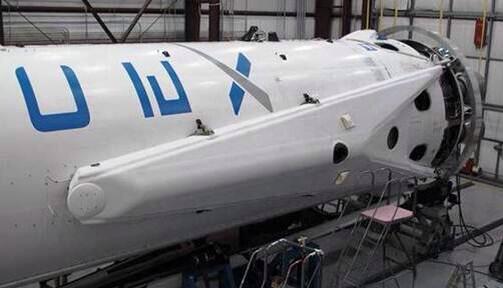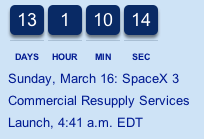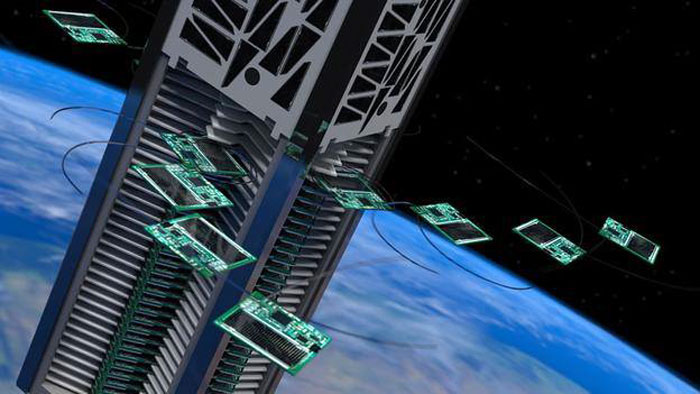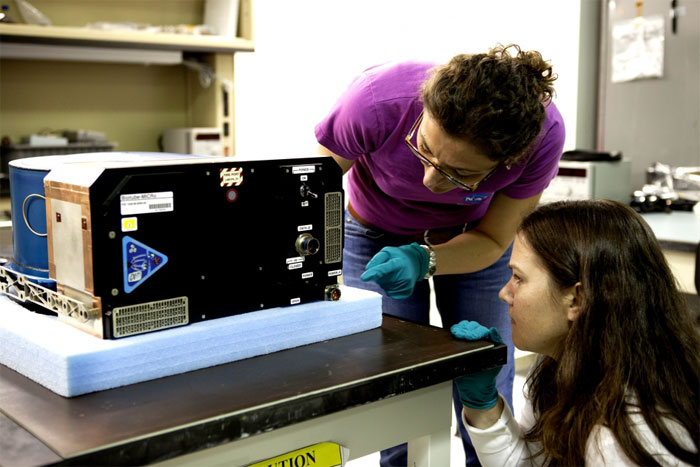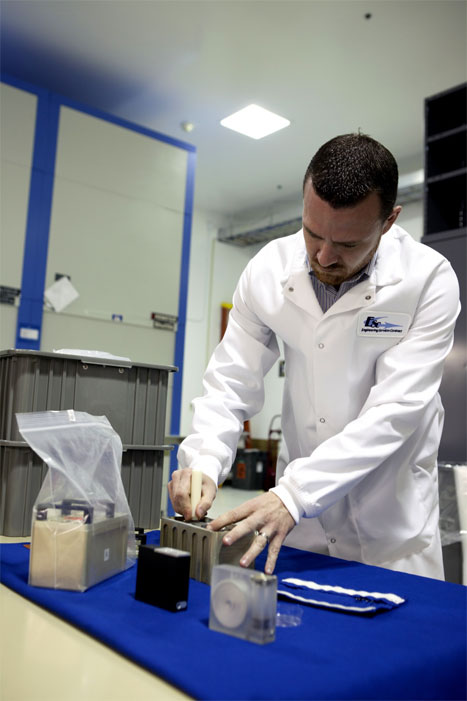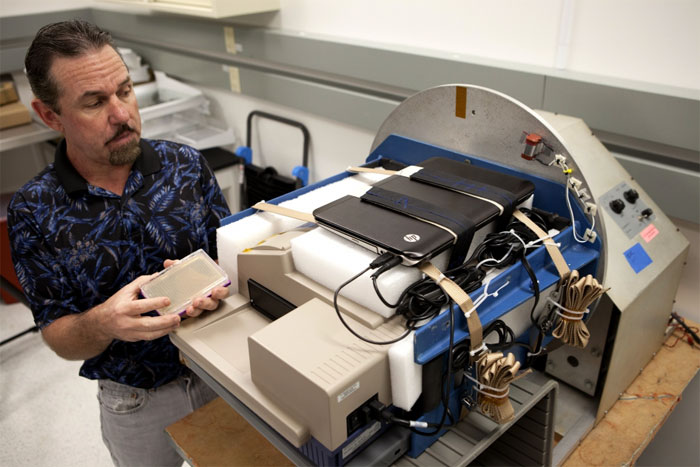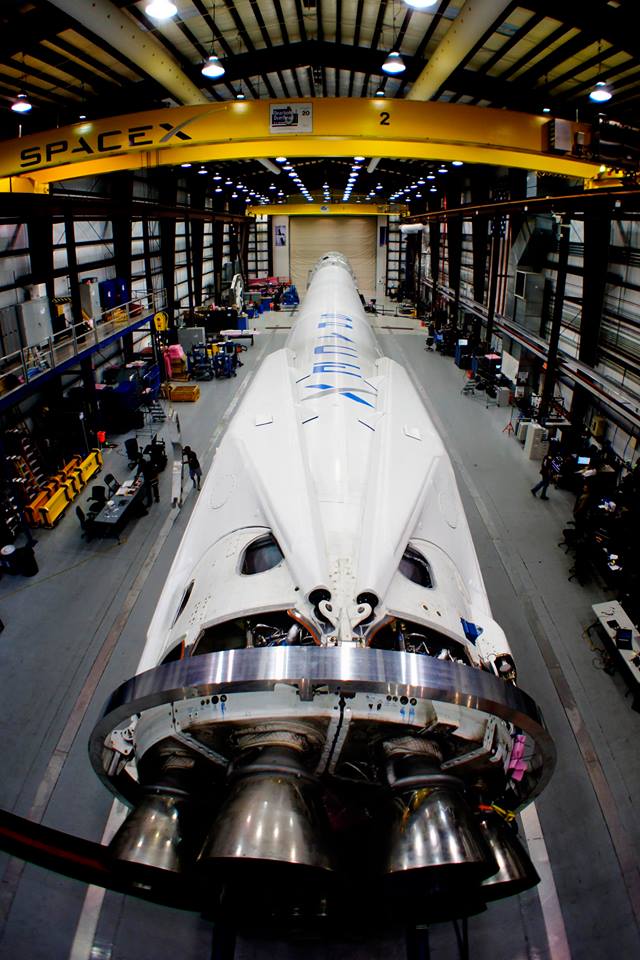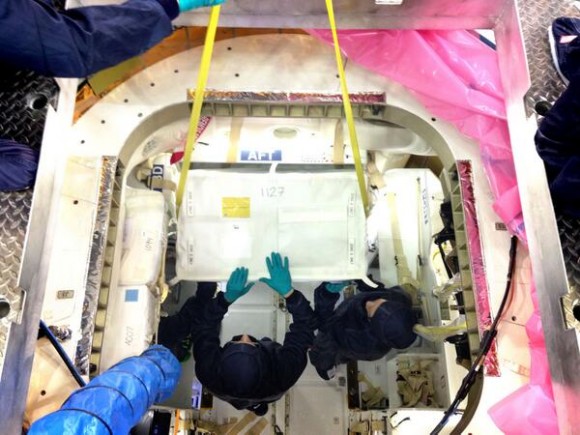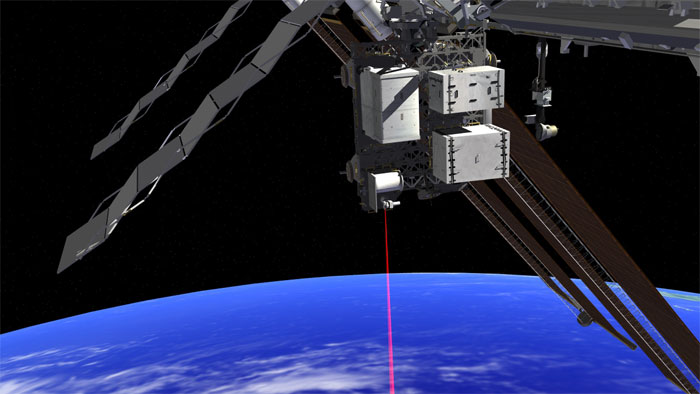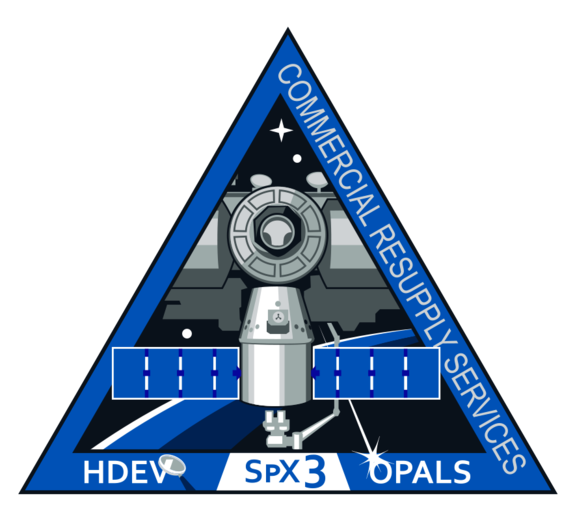.9.02.2014

.
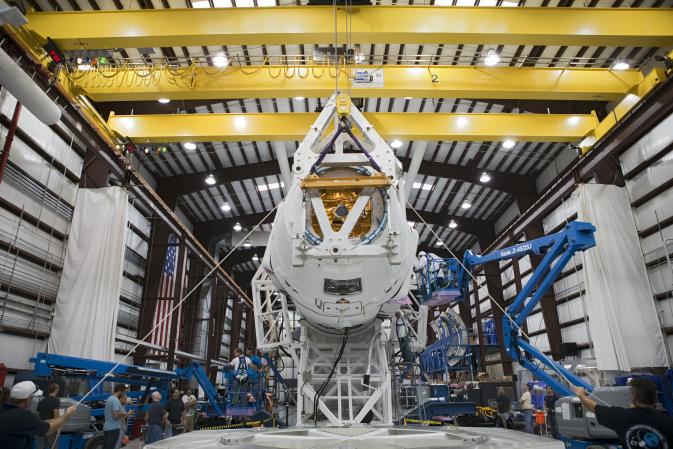
Technicians attach the Dragon capsule to a Falcon 9 rocket at the SpaceX facility at Cape Canaveral Air Force Station, Fla., during preparations for the SpaceX 1 mission.
.
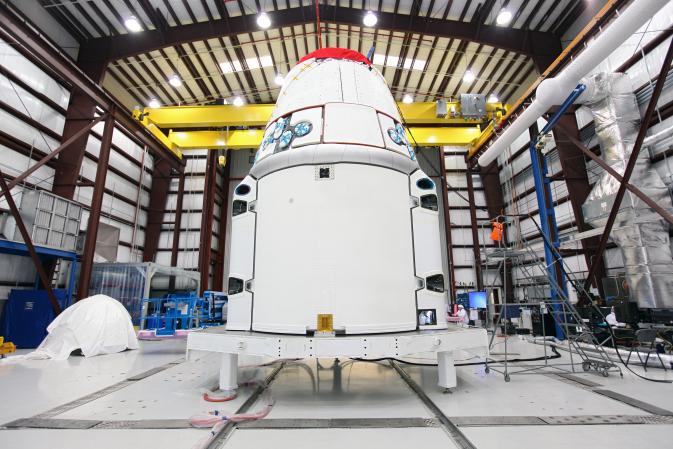
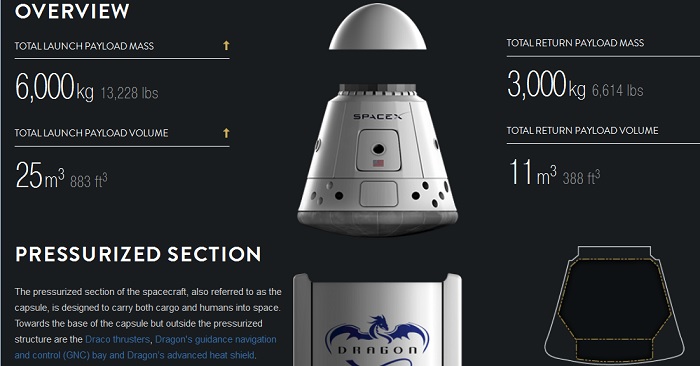
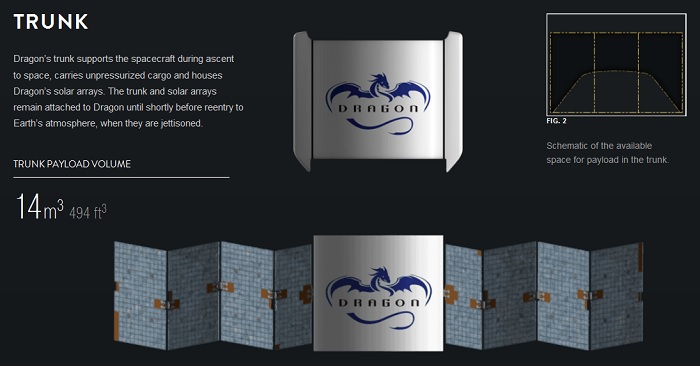
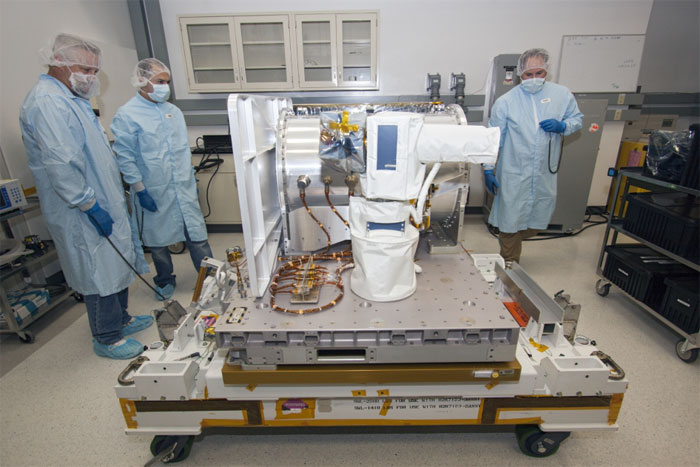

Launch Updates

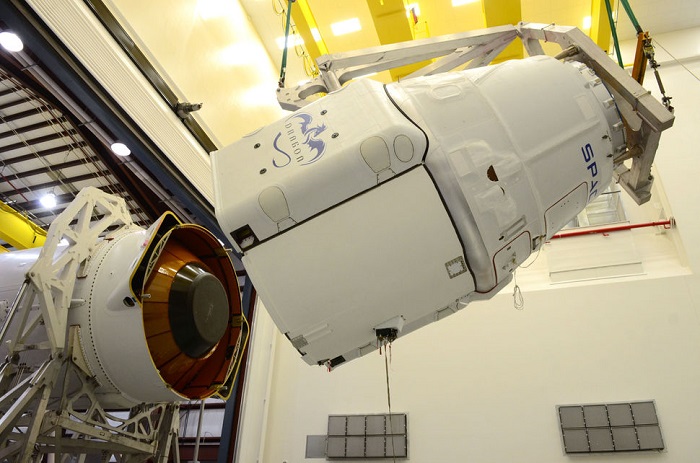
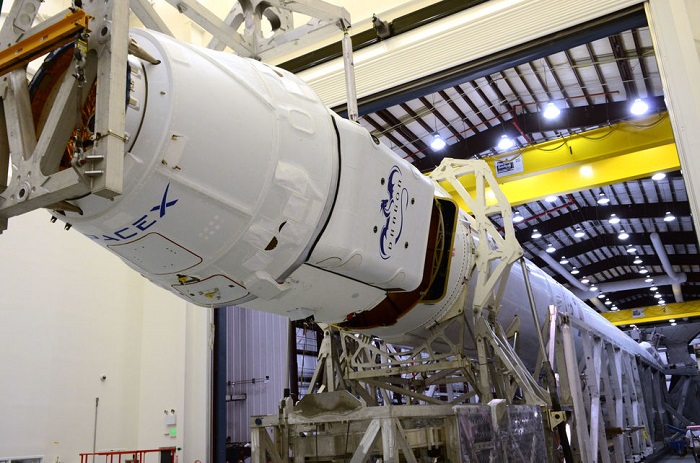
No specific systems were cited as needing additional work, but both a Falcon 9 rocket and Dragon capsule packed with more than 4,000 pounds of ISS cargo were said to be “in good health.”
“Given the critical payloads on board and significant upgrades to Dragon, the additional time will ensure SpaceX does everything possible on the ground to prepare for a successful launch,” said spokeswoman Emily Shanklin. April 2 would be the backup launch date for the company’s third of 12 ISS resupply missions under a $1.6 billion NASA contract.
SpaceX said the new dates were the earliest available launch opportunities on the Air Force’s Eastern Range, and are not yet approved.
With the slip, a United Launch Alliance Atlas V becomes the next vehicle in line to launch from Cape Canaveral Air Force Station, on March 25 with a National Reconnaissance Office satellite.
NASA Assessing SpaceX 'Payload Contamination
SpaceX has confirmed it will target its next cargo mission launch to the International Space Station from Cape Canaveral Air Force Station in Florida, for 10:50 p.m. EDT, Sunday, March 30.
NASA Television launch coverage begins at 9:45 p.m. for the company's third contracted resupply mission to the orbital laboratory. A post-launch news conference will follow at approximately 90 minutes after liftoff. If for any reason the launch is postponed, the next launch opportunity is 9:39 p.m. Wednesday, April 2, with NASA TV coverage beginning at 8:30 p.m.
NASA TV also will air a prelaunch news conference at 1 p.m. Saturday, March 29 at the agency's Kennedy Space Center in Florida. A 2 p.m. briefing on the science and technology cargo being delivered to the space station by SpaceX will follow.
A March 30 launch would result in SpaceX's Dragon spacecraft arriving at the station on Wednesday, April 2 at approximately 7 a.m. NASA TV coverage of rendezvous and berthing will begin at 5:45 a.m. for a 7 a.m. capture. Coverage of Dragon's installation will begin at 9:30 a.m.
Quelle: NASA
.
Update: 31.03.2014
.
.
Update: 5.04.2014
.
ULA, SpaceX reschedule launches after radar outage
After a two-week delay to wait for the U.S. Air Force to restore a critical radar tracker, United Launch Alliance and SpaceX have rescheduled their next rocket missions from Cape Canaveral for April 10 and April 14.
Officials put the launches on hold after a component on a rocket tracking radar short-circuited March 24, causing it to overheat and knock the radar offline.Without the radar, the Air Force's Eastern Range was unable to support launch attempts for the ULA Atlas 5 and SpaceX Falcon 9 rockets then set for March 25 and March 30.
The Eastern Range is a network of communications stations, tracking radars and safety assets along Florida's East Coast and stretching into the Atlantic Ocean under the ground tracks of rockets as they fly into orbit.
The range's job is to keep the public and property safe from launching rockets in case the vehicles fly off course.
The radar responsible for the delays is owned by the Air Force but lies on the property of NASA's Kennedy Space Center.
First up on April 10 is the Atlas 5 launch of a top secret payload for the National Reconnaissance Office, the U.S. government agency which owns and operates imaging and eavesdropping spy satellites.
Liftoff from Cape Canaveral's Complex 41 launch pad is set for a launch window opening at 1:45 p.m. EDT (1745 GMT) and extending 41 minutes.
The April 10 launch will come one week after an Atlas 5 launch from Vandenberg Air Force Base in California with the military's DMSP F19 weather satellite.
A Falcon 9 rocket is scheduled for liftoff April 14 from the nearby Complex 40 pad with a Dragon cargo spacecraft heading to the International Space Station.The automated spaceship will deliver 2.4 tons of equipment to the space station under contract to NASA.
Launch on April 14 is set for 4:58 p.m. EDT (2058 GMT), and the Dragon spacecraft will arrive at the space station April 16.
A spokesperson with the Air Force's 45th Space Wing on Friday said the Eastern Range is expected to be ready to support both launches. He did not say whether the Air Force had repaired the damaged radar or activated a backup system to restore the lost tracking capability.
.
The next SpaceX cargo mission to the International Space Station under NASA's Commercial Resupply Services contract is scheduled to launch Monday, April 14, from Space Launch Complex 40 at Cape Canaveral Air Force Station in Florida.
The company's Falcon 9 rocket, carrying its Dragon cargo spacecraft, will lift off at approximately 4:58 p.m. EDT. NASA Television coverage of the launch begins at 3:45 p.m. If for any reason the launch is postponed, the next launch opportunity is Friday, April 18 at approximately 3:25 p.m.
The mission, designated SpaceX-3, is the third of 12 SpaceX flights contracted by NASA to resupply the space station. It will be the fourth trip by a Dragon spacecraft to the orbiting laboratory.
The spacecraft will be filled with almost 5,000 pounds of scientific experiments and supplies. The Dragon will remain attached to the space station's Harmony module until mid-May and splash down in the Pacific Ocean off the coast of Baja California with more than 3,000 pounds of experiment samples and equipment returning from the station.
NASA will host a prelaunch news conference at 1 p.m., Sunday, April 13, at the agency's Kennedy Space Center in Florida, followed by a SpaceX science and technology cargo news conference at 2 p.m. Both briefings, which are subject to a change in time, will be carried live on NASA TV and the agency's website. A post-launch briefing will be held approximately 90 minutes after launch.
If launch occurs April 14, NASA TV will provide live coverage Wednesday, April 16, of the arrival of the Dragon cargo ship to the International Space Station. Grapple and berthing coverage will begin at 5:45 a.m. with grapple at approximately 7 a.m. Berthing coverage begins at 9:30 a.m.
Quelle: NASA
.
Update: 10.04.2014
.
Veggie Will Expand Fresh Food Production on Space Station
.
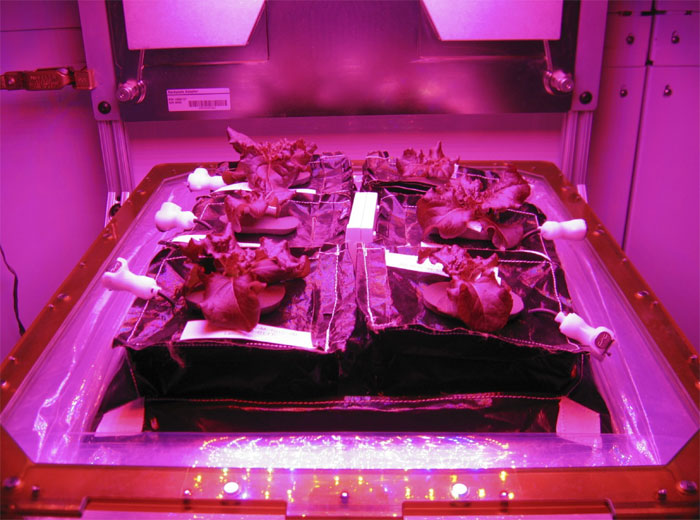
Outredgeous red romaine lettuce plants grow inside in a prototype Veggie flight pillow. The bellows of the hardware have been lowered to better observe the plants. A small temperature and relative humidity data logger is placed between the pillows small white box, centra
.
A plant growth chamber bound for the International Space Station inside the Dragon capsule on the SpaceX-3 resupply mission may help expand in-orbit food production capabilities in more ways than one, and offer astronauts something they don’t take for granted, fresh food.

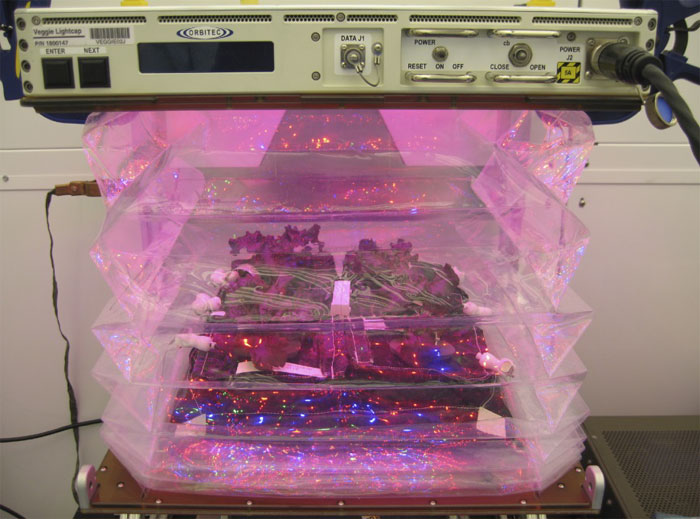
SpaceX "go" for Monday launch to ISS
A review today concluded with managers giving a "go" for SpaceX to proceed with a 4:58 p.m. Monday launch of cargo to the International Space Station.
The weather forecast at Cape Canaveral Air Force Station looks pretty good.
There's a 70 percent chance of conditions that would allow a Falcon 9 rocket and Dragon capsule to blast off from Launch Complex 40, according to Air Force meteorologists.
However, after a nice weekend, an approaching cold front on Monday increases the potential for thick clouds, thunderstorms or electrified anvil clouds near the launch site.
If there's no launch Monday, the next possible attempt would be four days later (Friday, April 18). Forecasted conditions then drop to a 40 percent chance of favorable launch weather.
SpaceX is launching its third ISS resupply mission under a $1.6 billion NASA contract.
Kennedy Space Center will host prelaunch media briefings on Sunday starting at 9 a.m. You can watch them live on NASA TV.
.
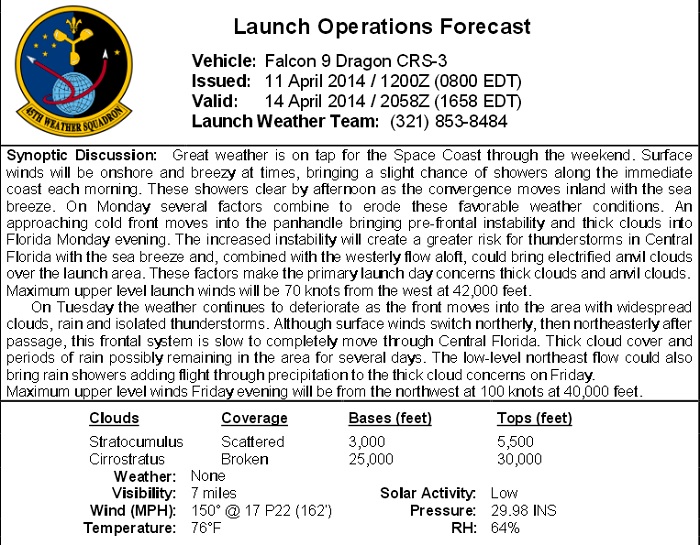
Quelle: Florida Today
The often-delayed launch of SpaceX Dragon cargo ship to the International Space Station, set for Monday afternoon, may be delayed yet again after a problem crept up with a computer module on the station.
The Multiplexer-Demultiplexer, or MDM, stopped responding to commands, NASA said in a statement Friday evening. The unit, mounted outside the ISS, backs up the main MDM in robotic-arm operations — such as the one that will be needed to attach the Dragon to the station upon its scheduled arrival Wednesday. From the statement:
The primary MDM operating aboard the space station is functioning normally and there is no immediate impact to space station operations. The computer outage does not pose a risk to the six crew members aboard the space station. ISS teams are assessing next steps to attempt to bring the computer back online or replace it. Replacing the backup MDM, if needed, would require a spacewalk. ... NASA is continuing to work toward a Monday launch of the SpaceX cargo resupply mission pending further evaluations by the ISS Program.
The Dragon was set to launch from Cape Canaveral, Fla., March 16 atop a Falcon 9 rocket when an alert was raised about possible contaminants in the Dragon's unpressurized exterior cargo space — its so-called "trunk." With that issue cleared, Dragon was go for a March 30 launch, but that was delayed by an electrical fire at a U.S. Air Force radar station needed to track the rocket, leading to the current April 14 date.
The current USAF forecast gives a 70 percent chance that weather will be favorable for launch Monday.
Quelle: Waco Tribune
.
Backup Computer Glitches On Space Station But Crew Safe, NASA Says
A backup computer that controls “some systems associated with robotics” on the International Space Station is not “responding to commands”, NASA said in a late-night statement Eastern time Friday (April 11).
The crew is safe, there’s no “immediate” change to space station operations, and because the primary computer is working, there’s also no alteration to the SpaceX Dragon launch to the station on Monday – which requires the robotic Canadarm2 for berthing. NASA added, however, that there are “further evaluations” going on, meaning the date could change depending on what controllers figure out.
If the computer does need to be replaced, crew members of Expedition 39 will need to do at least one spacewalk, the agency added. NASA is allowing contingency spacewalks in American spacesuits to go forward as the agency addresses problems raised in a report about a life-threatening spacesuit leak in July.
Below the jump is the statement NASA put out tonight concerning the situation.
.
A computer "black box" in the International Space Station's solar power truss that provides redundancy for robotic arm operations stopped responding to commands Friday, NASA said in a statement. If the component cannot be coaxed back to normal operation, the planned Monday launch of a SpaceX Dragon supply sh
6075 Views

